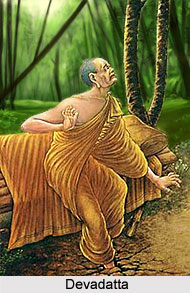 Devadatta was a Buddhist monk, who was also the cousin of Gautama Buddha. He created a schism in the Sangha or monastic community. This split was unsucessful as the later came back to the community. After that Devadatta also wanted to come back. Devadatta was always jealous of Buddha`s greatness and wisdom and wanted to become a religious leader by himself.
Devadatta was a Buddhist monk, who was also the cousin of Gautama Buddha. He created a schism in the Sangha or monastic community. This split was unsucessful as the later came back to the community. After that Devadatta also wanted to come back. Devadatta was always jealous of Buddha`s greatness and wisdom and wanted to become a religious leader by himself.
Devadatta`s original motivation to lead a holy life and become a monk was pure. But later corruption developed in him after he attained some supernatural power.
Devadatta attempted several times to kill Buddha.First time he hired some archers to kill Buddha. But when the archers saw Buddha was coming they approached him and were converted to Buddhism. Second time he tried to role a boulder towards him. He missed his target and the boulder cracked into pieces. One of the splinters hit Buddha`s feet and blood came out. According to Buddhism, this was due to `anantarika-kammas`, the five most flagitious deeds a human can perform. Third time Devadatta tried to kill Buddha by inciting an elephant. The elephant was pacified when he saw Buddha as Buddha directed `metta` to it.
According to Sutta pitaka, after Devadatta tried to kill Sakyamuni a number of times wanted to set up his own monastic order by splitting the monastic community or Sangha in two. It was also an Anantarika-karma. Thus Devadatta became the leader of the rebellion monks and added five extra-strict rules for them, which he knew that Buddha would never allow. Devadatta reasoned that after he had proposed these rules, Buddha had not allowed them. Devadatta claimed that he followed and practiced these five rules, which had made him better and more pure as a monk. One of this five rules was that a monk must be neceassarily a vegetarian.
According to Contemplation Sutta, Devadatta convinced Prince Ajatasatru to murder his father king Bimbisara to ascend the throne. Ajatasatru followed the advice and killed his father, which was another anatarika-karma. Later Ajatsatru listened to the preachings of Buddha but he could not attain the enlightenment due to this anantarika-karma. Devadatta is the only individual who had committed three anatarika-karmas.
When Sangha was split into two, it lost its popularity and reputation. Devadatta repented on what he did and wanted to make sincere apology to Buddha. He returned to the monastery where Buddha was living at that time. As soon as he entered the monastery he realized some of his bad karma and the earth splitted to draw him into the deepest hell known as hell of Avici.
In other scripts, towards the end of his life, Devadatta was seriously regretful because of his past misdeeds, and manage to approach Buddha to take the refuge of triple gem.As his sins were very serious, after his death he was condemned to suffer several hundred millenia in Avici hell. Buddha also mentioned that Devadatta would be eventually transferred to the heavens as a Paccheka because of his past merits before corruption.
In the lotus Sutra of mahayana tradition, there is the description how Buddha mentioned about Devadatta`s eventual transformation into an enlightened and compassionate being. It indicates that if enough time is given, even the worst individuals come under Buddhas compassion regardless their bad karma.



















